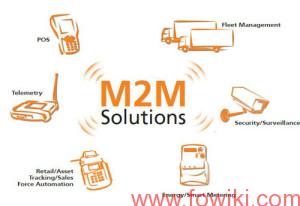M2M Introduction
Machine to machine (M2M) is a broad label that can be used to describe any technology that enables networked devices to exchange information and perform actions without the manual assistance of humans. In other terms: M2M refers to technologies that allow both wireless and wired systems to communicate with other devices of the same type.[1][2] M2M is a broad term as it does not pinpoint specific wireless or wired networking, information and communications technology. This broad term is particularly used by business executives. M2M is considered an integral part of the Internet of Things (IoT) and brings several benefits to industry and business [3] in general as it has a wide range of applications such as industrial automation, logistics, Smart Grid, Smart Cities, health, defence etc. mostly for monitoring but also for control purposes.(Source from WIKI)

M2M communication is often used for remote monitoring. In product restocking, for example, a vending machine can message the distributor when a particular item is running low. M2M communication is an important aspect of warehouse management, remote control, robotics, traffic control, logistic services, supply chain management, fleet management and telemedicine. It forms the basis for a concept known as the Internet of Things (IoT).
Key components of an M2M system include sensors, RFID, a Wi-Fi or cellular communications link and autonomic computing software programmed to help a networked device interpret data and make decisions. The most well-known type of M2M communication is telemetry, which has been used since the early part of the last century to transmit operational data. Pioneers in telemetrics first used telephone lines — and later, on radio waves — to transmit performance measurements gathered from monitoring instruments in remote locations. The Internet and improved standards for wireless technology have expanded the role of telemetry from pure science, engineering and manufacturing to everyday use in products like home heating units, electric meters and Internet-connected appliances. Products built with M2M communication capabilities are often marketed to end users as being “smart.”
Currently, M2M does not have a standardized connected device platform and many M2M systems are built to be task- or device-specific. It is expected that as M2M becomes more pervasive, vendors will need to agree upon standards for device-to-device communications. (Source from TechTarget)